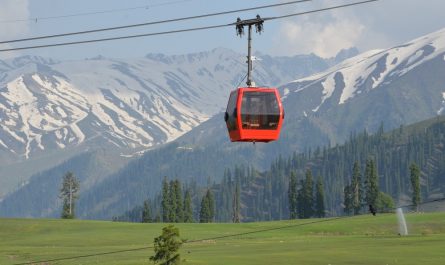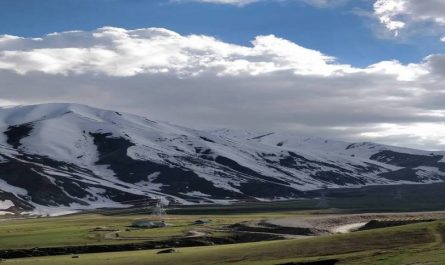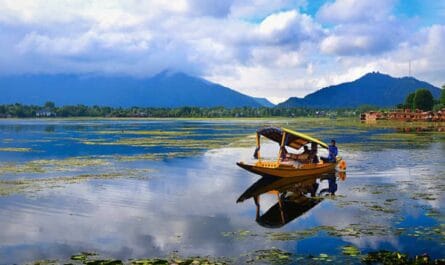Top Tourist Attractions in Srinagar
Srinagar is the biggest city and summer capital of Jammu and Kashmir, a union state governed by India. On the banks of the Jhelum River, a tributary of the Indus, and the Dal and Anchar lakes, it is located in the Kashmir Valley. The city’s natural surroundings, gardens, waterfronts, and houseboats are well-known.
Srinagar is one of numerous cities that have been dubbed the “East Venice” or “Kashmiri Venice.”
Dal Lake, which is known for its houseboats, and Nigeen Lake are two of the city’s lakes.
Mughal gardens may be found in Srinagar, and they are part of a network of gardens built by Mughal rulers across the Indian subcontinent. Those in Srinagar and the surrounding area include:
Best Places to Visit in Srinagar
- Chashma Shahi
- Badamwari
- Nigeen Lake
- Dal Lake
- Hariparbat Fort
- Dachigam National Park
- Harwan
- Tulip Garden
- Botanical Garden
- Pari Mahal
- Nishat Garden
- Shalimar Garden
Pari Mahal
Pari Mahal, also known as The Angels’ Abode, is a seven-tiered garden at the summit of the Zabarwan mountain range, overlooking the city of Srinagar and south-west of Dal Lake. The building displays Islamic architecture and art patronage during the reign of the then-Mughal Emperor Shah Jahan. Mughal Prince Dara Shikoh constructed the Pari Mahal in the mid-1600s. It operated as both a library and a residence for him. Dara Shikoh was supposed to have resided in this area between 1640 and 1645 and again in 1654. It was also utilised as an observatory to educate astrology and astronomy. Cheshmashahi Garden is a five-minute drive away.
Botanical Garden
The Botanical Garden was founded in 1969. Located at the base of a hill with a view of Dal Lake. It is home to a diverse range of plants and flora. This garden has over 150,00 attractive plants as well as a large collection of oak types. It also contains a unique collection of Kashmiri tropical plants. This location attracts visitors from all around the world. The Plant Introduction Centre, the Research Section, the Recreational Garden, and the Botanical Garden are its four primary departments.
Tulip Garden
The Indira Gandhi Memorial Tulip Garden, formerly known as the Model Floriculture Center, is a tulip garden located in Srinagar. It is Asia’s largest tulip garden, spanning over 30 hectares. It is located on the Zabarwan Range’s slopes, with a view of Dal Lake. The garden was established in 2007 with the goal of promoting floriculture and tourism in the Kashmir Valley. The garden is tiered and created on a sloping terrain with seven tiers. Aside from tulips, several other flower species such as hyacinths, daffodils, and ranunculus have been added. Tulip festival is an annual event that attempts to promote the variety of blooms in the garden as part of the Government of Jammu and Kashmir’s tourist initiatives. It is held at the start of the spring season in Kashmir valley.
Harwan Garden
Harwan Garden, located in Harwan Village (19 kilometres from Srinagar), is a vast and well-known tourist attraction. Starting from a lake close behind the garden and flowing through the heart of the garden, a canal elegantly flanked with Chinar trees and gorgeous flower beds. The natural beauty and charm of the Harwan garden are its main draws. With vegetation in the backdrop of a winter climate, this garden boasts large green grass fields that draw tourists in. The garden, which is only a half-hour taxi ride away, is great for picnics and excursions, as well as a nature walk. It serves as the entrance of the Dachi Gam Wildlife Sanctuary.
Dachigam National Park
Dachigam National Park is located in Jammu & Kashmir, 22 kilometres (kilometres) from Srinagar. It has a total size of 141 square kilometres (square kilometer). The name literally means “10 towns,” which might refer to the ten villages that were moved to make way for the park. Dachigam was first created to provide the supply of safe drinking water to the city of Srinagar. It has been a protected area since 1910 and was designated as a national park in 1981. The park is most recognised for being the habitat of the hangul, often known as the Kashmir stag. Dachigam is open all year, although the ideal months to visit are April through August. Srinagar is the nearest airport. Kashmir Stag Habitat: The only region where Kashmir Stag may be found.
Hari Parbat Fort
Hari Parbat, also known as Kooh-e-Maran, is located west of Dal Lake in Srinagar, Jammu and Kashmir’s UT. This Mughal edifice was erected in the 18th century by Afghan Governor Atta Mohammed Khan. Later, in 1590, Emperor Akbar built a lengthy wall. This fort is at the top of the hill, surrounded by beautiful constructions from all religions, and offers a great view of Dal Lake. The Archaeological Survey of India (ASI) maintains this fort, which still stands impressively with historic rooms and huge pillars. Hari Parbat offers a panoramic view of the Makhdoom Sahib shrine.
Dal Lake
Dal is a lake in Srinagar, the summer capital of Jammu and Kashmir (Dal Lake is a misnomer because Dal in Kashmiri means lake). The urban lake, known as the “Jewel in the Crown of Kashmir” or “Srinagar’s Jewel,” is essential to tourism and relaxation in Kashmir. The lake is also a vital source of commercial fishing and water plant harvesting. The lake’s shoreline is approximately 15.5 kilometres (9.6 miles) long and is surrounded by a promenade lined with Mughal-era gardens, parks, houseboats, and hotels. Views of the lake may be seen from the shoreline Mughal gardens, including as Shalimar Bagh and Nishat Bagh, which were established during the time of Mughal Emperor Jahangir, as well as from houseboats travelling about the lake in colourful shikaras. During the winter, the temperature can reach 11 °C (12 °F), freezing the lake.
The lake is 18 square kilometres (6.9 square miles) in size and is part of a natural wetland that is 21.1 square kilometres (8.1 square miles) in size, including its floating gardens. During the months of July and August, the floating gardens, known as “Raad” in Kashmiri, bloom with lotus flowers. The marsh is split into four basins by causeways: Gagribal, Lokut Dal, Bod Dal, and Nagin (although Nagin is also considered as an independent lake). Both Lokut-dal and Bod-dal have a central island known as Rup Lank (or Char Chinari) and Sona Lank, respectively. Houseboats are strongly linked with Dal Lake and provide lodging for tourists in Srinagar.
Nigeen Lake
Nigeen Lake (also known as Nageen Lake) is a slightly eutrophic lake in Srinagar, Jammu & Kashmir, India. It is sometimes thought to be a part of Dal Lake and is linked to it by a thin strait. It is also linked to the Khushal Sar and Gil Sar lakes by the Nallah Amir Khan waterway. Nigeen Lake is bordered by a dense forest of willow and poplar trees. As a result, it has come to be known as a “nageena,” which means “the diamond in the ring.” A local variation of the same term is “nigeen.”
The lake is located to the west of the Dal lake, near to the Hari Parbat mountain. To the north-east of it is the town of Hazratbal, which is famed for its shrine. The lake is a prominent tourist destination in Srinagar, and it is recognised for its more pure waters in comparison to the Dal lake. Houseboats and Shikaras are common sightings. It’s also great for swimming because it’s deeper and less busy than Dal Lake.
Badamwari
The early blossoming of blooms on Almond trees in Shahr-e-Khaas’ expansive mediaeval Badamwari garden has been a draw for nature enthusiasts and visitors alike. The 300-kanal garden, located on the slopes of Koh-e-Maran, was studded with trees, flowers, and cascades, giving visitors with a relaxing experience. Historians claim there is no record of who built the garden, although they claim it existed before Sultan Zain-ul-14th-century Abidin’s reign. Warris Shah, an Afghan king, is commemorated with a well-covered dome in the garden. The blooming of the Almond trees signalled the arrival of spring. In 2008, the garden was resurrected and publicly opened to the public.
Chashma Shahi
Chashma Shahi, also known as Chashma I Shahi (translation: the royal spring), is one of the Mughal gardens erected in 1632 AD around a spring by Ali Mardan Khan, a governor of Mughal emperor Shah Jahan on the Emperor’s instructions, as a present for his eldest son Prince Dara Shikoh. The garden is located in Srinagar, Kashmir, near the Raj Bhawan (Governor’s House) and overlooks Dal Lake.
Best Time to Visit in Srinagar
Anytime
Srinagar has a pleasant climate and therefore, travelers love to visit the city all through the year. However, the best time to visit Srinagar is from April to October. During this period, people can admire the real beauty of this city as the whole valley gets covered with blossoms.
How to Reach Srinagar
By Air:
Named Sheikh ul Alam Airport (IATA code SXR) , Srinagar Airport is an international airport. This airport is well connected and airlines offer regular flights from Srinagar to Delhi, Mumbai and Chandigarh. The airport is placed just 15 km away from the center of the city.
Nearest Airport : Srinagar Airport, Srinagar
By Rail:
To reach Srinagar by train, one has to reach either Banihal railway station. From the Srinagar Railway station, you can hire Cabs / taxis to reach this magnificent place.
By Road:
Srinagar is the capital of the Jammu and Kashmir UT. The city is well connected with major cities like Delhi (876 km), Chandigarh (646 km), Leh (424 km) and Jammu (258 km).There is good Bus service and Cab service available.





